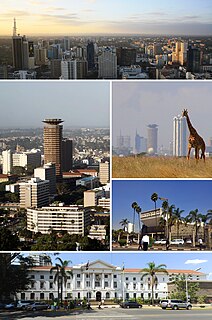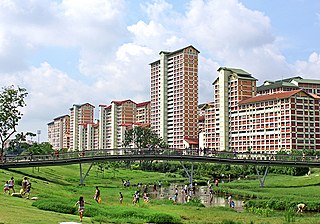
Nairobi is the capital and largest city of Kenya. The name is derived from the Maasai phrase Enkare Nairobi, which translates to "place of cool waters", a reference to the Nairobi River which flows through the city. The city proper had a population of 4,397,073 in the 2019 census, while the metropolitan area has a population of 9,354,580. The city is commonly referred to as the Green City in the Sun.

Public housing is a form of housing tenure in which the property is usually owned by a government authority, either central or local. Although the common goal of public housing is to provide affordable housing, the details, terminology, definitions of poverty, and other criteria for allocation vary within different contexts. Public housing housing developments are classified as housing projects that are owned by a city's Housing authority or Federally subsidized public housing operated through HUD. Social housing is any rental housing that may be owned and managed by the state, by non-profit organizations, or by a combination of the two, usually with the aim of providing affordable housing. Social housing is generally rationed by a government through some form of means-testing or through administrative measures of housing need. One can regard social housing as a potential remedy for housing inequality. Private housing is a form of housing tenure in which the property is owned by an individual, private developer or by a non-profit organization. Privately owned apartment complexes are multifamily subsidized housing, where the subsidy is given to the owner who provides affordable housing. This subsidy stays with the property.
Limuru is a town in central Kenya. It is also the name of a parliamentary constituency and an administrative division. The population of the town, as of 2004, was about 4,800. In a census taken in 2019 the population had increased to 159,314.
Subsidized housing is government sponsored economic assistance aimed towards alleviating housing costs and expenses for impoverished people with low to moderate incomes. In the United States, subsidized housing is often called "affordable housing". Forms of subsidies include direct housing subsidies, non-profit housing, public housing, rent supplements/vouchers, and some forms of co-operative and private sector housing. According to some sources, increasing access to housing may contribute to lower poverty rates.

State housing is a system of public housing in New Zealand, offering low-cost rental housing to residents on low to moderate incomes. Some 69,000 state houses are managed by Kāinga Ora – Homes and Communities, most of which are owned by the Crown. In excess of 31,000 former state houses exist, which are now privately owned after large-scale sell-offs during recent decades. Since 2014, state housing has been part of a wider social housing system, which also includes privately owned low-cost housing.
Buy-to-let is a British phrase referring to the purchase of a property specifically to let out, that is to rent it out. A buy-to-let mortgage is a mortgage loan specifically designed for this purpose. Buy-to-let properties are usually residential but the term also encompasses student property investments and hotel room investments.
Kariobangi is a low-income residential estate in northeastern Nairobi, Kenya. It consists of both apartments and slum-type dwellings. It is split into two parts, Kariobangi North and Kariobangi South. The northern part was constructed first, with first buildings built in 1961. Kariobangi North is part of the Embakasi North electoral constituency. Kariobangi South is in the Embakasi West constituency.
The private rented sector (PRS) is a classification of United Kingdom housing tenure as described by the Ministry of Housing, Communities and Local Government, a UK government department that monitors the national housing supply.

Affordable housing is housing which is deemed affordable to those with a household income at or below the median as rated by the national government or a local government by a recognized housing affordability index. Most of the literature on affordable housing refers to mortgages and a number of forms that exist along a continuum – from emergency homeless shelters, to transitional housing, to non-market rental, to formal and informal rental, indigenous housing, and ending with affordable home ownership.

The Mitchell–Lama Housing Program is a non-subsidy governmental housing guarantee in the state of New York. It was sponsored by New York State Senator MacNeil Mitchell and Assemblyman Alfred Lama. It was signed into law in 1955 as The Limited-Profit Housing Companies Act.

Home ownership in Australia is considered a key cultural icon, and part of the Australian tradition known as the Great Australian Dream of "owning a detached house on a fenced block of land." Home ownership has been seen as creating a responsible citizenry; according to a former Premier of Victoria: "The home owner feels that he has a stake in the country, and that he has something worth working for, living for, fighting for."
Public housing policies in Canada includes rent controls, as well as subsidized interest rates and grants. Early public housing policy in Canada consisted of public-private lending schemes which focused on expanding home ownership among the middle class. The first major housing initiative in Canada was the Dominion Housing Act of 1935, which increased the amount of credit available for mortgage loans.
National Housing and Construction Company Limited (NHCC), is a Ugandan construction and real estate management company, partly owned by the Uganda Government. The Company’s mandate is to increase the housing stock in the country, rehabilitate the housing industry and encourage Ugandans to own homes in an organized environment.

Formerly known as Riverside Park Community, the apartment complex now known as 3333 Broadway is a group of five buildings ranging in height from 11 to 35 stories at 3333 Broadway between West 133rd and 135th Streets, in Harlem, Manhattan, New York City, United States. Completed in 1976, it was the largest residential structure in the United States. Together, the five buildings include 1,200 apartment units and were designed to accommodate nearly 1,190 families. The complex also includes the KIPP Infinity Middle School. The present manager of the property is the Urban American Management Corporation.

Housing in the state of Victoria, Australia is characterised by high rates of private housing ownership, minimal and lack of public housing and high demand for, and largely unaffordable, rental housing. Outside of Melbourne, home to 70% of the state's population, housing and rent is more affordable. In Melbourne, access to public housing is generally better, but housing and rent are less affordable.
Housing Finance Company Limited, commonly referred to as Housing Finance, is a commercial bank in Kenya, regulated by the Central Bank of Kenya, the central bank and national banking regulator. HFC is major mortgage lender in Kenya and was the second-largest in the market with KSh33.7 billion in mortgage loans, as of December 2019. At that time, Kenya Commercial Bank, the largest mortgage lender in the country had KSh64.3 billion in mortgage loans.
Madaraka Estate is a middle class residential neighbourhood in Nairobi located approximately 5 km (3.1 mi) from the city center. The word madaraka is Swahili for self governance while “estate” refers to a housing development. Popularly known as Madaa, the neighbourhood is one of Nairobi City Council’s oldest housing developments besides Jamhuri, Huruma Mariakani and Kariakor estates. It is located approximately 200 meters from Nyayo National Stadium on Lang’ata Road which branches off A104 the intercity highway that links Nairobi to Mombasa. Madaraka is bordered by other popular residential areas such as Nairobi West, Upper Hill, Kenyatta Estate, Mawenzi, Mbagathi, Nyayo Highrise, AP Camp, and Siwaka. It sits on 45 acres of land in a location highly coveted for its close proximity and accessibility to the city. Kibera, Nairobi's largest slum is also about 3 miles from Madaraka. Popular spot is called Kilosh
Non-profit housing developers build affordable housing for individuals under-served by the private market. The non-profit housing sector is composed of community development corporations (CDC) and national and regional non-profit housing organizations whose mission is to provide for the needy, the elderly, working households, and others that the private housing market does not adequately serve. Of the total 4.6 million units in the social housing sector, non-profit developers have produced approximately 1.547 million units, or roughly one-third of the total stock. Since non-profit developers seldom have the financial resources or access to capital that for-profit entities do, they often use multiple layers of financing, usually from a variety of sources for both development and operation of these affordable housing units.
The continuum of affordable housing in Canada includes market, non-market, and government-subsidized housing.

Affordable housing is a housing which is deemed affordable to those with a median household income as rated by the national government or a local government by a recognized housing affordability index. A general rule is no more than 30% of gross monthly income should be spent on housing, to be considered an affordable for the challenges of promoting affordable housing varies by location.








